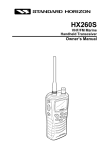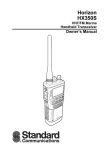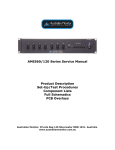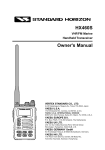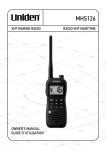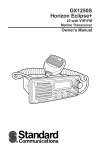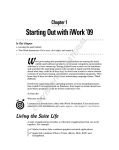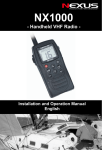Download HX150S DFU rev.2 - Standard Horizon
Transcript
Horizon HX150S VHF/FM Marine Handheld Transceiver Owner’s Manual PW R HX150S Owner’s Manual page 19 TABLE OF CONTENTS GENERAL INFORMATION .......................................................... 1 INTRODUCTION ........................................................................... 1 FCC/ INDUSTRY CANADA INFORMATION ................................ 1 ACCESSORIES ............................................................................ 2 PACKING LIST ............................................................................. 2 OPTIONS ...................................................................................... 2 REPLACEMENT PARTS .............................................................. 2 CONTROLS AND INDICATORS .................................................. 3 CONTROLS AND CONNECTIONS .............................................. 3 INDICATORS ................................................................................ 6 OPERATION ................................................................................. 8 INITIAL PROCEDURE .................................................................. 8 RECEPTION ................................................................................. 8 TRANSMISSION ........................................................................... 9 TRANSMIT TIME - OUT TIMER (TOT) ....................................... 10 USA, CANADIAN AND INTERNATIONAL MODES .................... 10 WEATHER CHANNELS .............................................................. 10 SCAN .......................................................................................... 10 WEATHER ALERT ...................................................................... 11 CLEARING THE TRANSCEIVER’S MEMORY ........................... 11 EMERGENCY CHANNEL 16 ...................................................... 12 CHANNEL 9 ................................................................................ 12 OPERATING ON CHANNEL 13 ................................................. 12 OPERATING ON CHANNEL 67 ................................................. 12 SIMPLEX/DUPLEX CHANNEL USE........................................... 12 BATTERY ................................................................................... 13 BATTERY CHARGING ............................................................... 13 BATTERY REMOVAL/INSTALLATION ...................................... 13 OPERATING BATTERY CHARGE SYSTEM ............................. 14 BATTERY SAFETY ..................................................................... 15 MAINTENANCE .......................................................................... 16 SPECIFICATIONS ...................................................................... 17 GENERAL ................................................................................... 17 TRANSMITTER ........................................................................... 17 RECEIVER .................................................................................. 17 page 20 Owner’s Manual HX150S 1 GENERAL INFORMATION 1.1 INTRODUCTION The Standard Communications Corp. (SCC) HX150S is a marine handheld two-way VHF transceiver. The transceiver has 65 channels: 55 marine and 10 weather. The 55 marine channels are switchable to comply with either USA, International, or Canadian regulations. It has an emergency channel 16 which can be immediately selected from any channel by pressing the red 16/9 key. Weather channels can also be accessed immediately by pressing the WX key. The transceiver includes the following features: scanning, weather alert, easy-to-read LCD display, EEPROM memory back-up, low battery indication, and a transmit time-out timer (TOT). 1.2 FCC/ INDUSTRY CANADA INFORMATION The following data pertaining to the transceiver is necessary to fill out the license application. FCC Type Accepted ........................................................................ Part 80 Output Power with CNB300 battery .......... 1 watt (Low) and 5 watts (High) Emission ...................................................................................... 16K0F3E Frequency Range ............................................... 156.025 to 163.275 MHz FCC Type Number ...................................................................... APV0596 Industry Canada Type Approval ....................................... 363822181AVP Additional FCC and Industry Canada data, including licensing requirements, are contained in the companion document titled OWNER’S MANUAL SUPPLEMENT. The document also contains charts for VHF channel assignments, transceiver procedures, maintenance, factory service information, and warranty data. WARNING! This transmitter will operate on channels/frequencies that have restricted use in the United States. The channel assignments include frequencies assigned for exclusive use of the U.S. Coast Guard, use in Canada, and use in International waters. Operation in these frequencies without proper authorization is strictly forbidden. For frequencies/channels that are currently available for use in the U.S. without an individual license, please contact the FCC Call Center at 1 - 888 - CALL - FCC. HX150S Owner’s Manual page 1 2 ACCESSORIES 2.1 PACKING LIST When unpacking the transceiver, please check for the following contents: • HX150S Transceiver • CNB300 Rechargeable battery pack (7.2 V, 600 mAh) • CWC231 120VAC Wall charger • CAT150 Flexible Antenna with STUD connector • Lanyard • CBT300 Battery Tray kit (Battery tray, Battery lid, Battery clamper) • Belt Clip • Owner’s Manual • Owner’s Manual Supplement 2.2 OPTIONS CMC240 .............................. DC Charge Cable with 12 V Cigarette Lighter CMB240 .............................................................................. Mobile Bracket CNB301 ................................ Rechargeable Battery Pack (7.2V1100mAh) 2.3 REPLACEMENT PARTS Flexible Antenna with STUD Connector ....................................... CAT150 Rechargeable Battery Pack .......................................................... CNB300 Belt Clip .................................................................................. 365B258012 Lanyard .................................................................................. 458C156040 Battery Tray kit .............................................................................. CBT300 page 2 Owner’s Manual HX150S 3 CONTROLS AND INDICATORS NOTE This section defines each control of the transceiver. For detailed operating instructions refer to section 4 of this manual. Refer to Figure 1 for the location of the following controls, indicators, and connections. 3.1 CONTROLS AND CONNECTIONS q POWER SWITCH (PWR) Turns the transceiver on and off. Press and hold down this switch for one second or more to turn the power on. Press and hold down this switch for 2 seconds or more to turn the power off . w VOLUME KEY (VOL) Activates the volume adjusting mode. Press this key to activate the volume adjusting mode. Press the UP or DOWN key to adjust the volume. e SQUELCH KEY (SQL) Activates the squelch adjusting mode. Press this key to activate the squelch adjusting mode. Press the UP or DOWN key to adjust the squelch. Sets the point at which random noise on the channel does not activate the audio circuits but a received signal does. This point is called “squelch threshold”. Further adjustment of the squelch control will degrade the reception of wanted transmissions. r PUSH-TO-TALK (PTT) SWITCH Activates transmission. t UP KEY Selects the desired channel and adjusts the volume and squelch levels. Each press increases the channel number ,volume level, and squelch level. When held down, the channels increase continuously. HX150S Owner’s Manual page 3 !1 LAMP/ KEY LOCK KEY !2 ANTENNA CONNECTOR r PTT SWITCH w VOLUME KEY !4 BELT CLIP y DOWN KEY PWR !0 H/L KEY q POWER SWITCH o SCAN KEY INDICATOR e SQUELCH KEY t UP KEY u 16/9 KEY i WX KEY SPEAKER MICROPHONE !5 DC IN CONNECTOR !3 BATTERY TRAY Figure 1. CONTROLS AND CONNECTORS y DOWN KEY Selects the desired channel and adjusts the volume and squelch levels. Each press decreases the channel number, volume level and squelch level. When held down, the channels decrease continuously. u 16/9 KEY Immediately recalls channel 16 from any channel location. Hold down this key for 1 second or more to recall channel 9. Recalls the previous channel when 16/9 key is pressed again. When the WX key is pressed and this key is pressed and held down, the mode toggles between USA, International and Canadian. i WX KEY Immediately recalls a weather channel from any channel location. Recalls the previous channel when WX key is pressed again. page 4 Owner’s Manual HX150S o SCAN KEY Starts scanning programmed channels. Stops the transceiver from scanning when pressed during the scan. !0 H/L KEY Toggles between high and low power. To change from low power to high power on Canadian channel 13, USA channel 13 or 67, press and release this key and hold down the PTT switch. High power setting is canceled after the transmitting on these channels. !1 Lamp/ Key Lock KEY Turns the lamp for LCD backlighting on and off. Hold down this key to lock the displayed channel functions (except for the H/L, PTT, PWR and Lamp/ Key Lock keys) so they are not accidentally changed. The key lock symbol “ ” appears when the channel is locked. Hold down this key until the key lock symbol disappears to unlock the channel. !2 Antenna Connector Connects the flexible antenna CAT150. !3 Battery Tray with Battery Pack Provides DC power to the transceiver !4 Belt Clip To remove the belt clip, pull the stopper and slide the belt clip upward. STOPPER !5 DC IN Connector Connects the wall charger CWC231. (see section 5.3) HX150S Owner’s Manual page 5 3.2 INDICATORS T X BUSY USA I NT L CAN S D MEM H L SQL VOL A Channel Display Displays the operating channel in both transmission and reception mode. A Indicator A simplex channel in USA or Canadian mode whose counterpart in the International mode is a duplex channel. TX/ BUSY Indicator “TX” is in transmitting . “BUSY” is in receiving. USA/ INTL/ CAN Indicator The modes of operation for the particular channel. “USA” indicates USA mode. “INTL” indicates International mode and “CAN” indicates Canadian mode. WX Indicator A weather channel. MEM Indicator The channel is in the transceiver's scan memory. H/L Indicator “H” is high power. “L” is low power. Blank is a reception only channel. SQL/VOL Indicator “SQL” is squelch adjusting mode. “VOL” is volume adjusting mode. Key Lock Symbol A“ ” appears when the channel is locked. All keys are disabled except for the H/L, PTT, PWR and Lamp/ Key Lock keys. page 6 Owner’s Manual HX150S Low Battery Indicator A“ ” appears when the battery capacity is less than 10%. NOTE The battery indicator should be used only as a guide in charging the CNB300 battery. Output Power Indicator “ HX150S ” is high power. “ ” is low power. Owner’s Manual page 7 4 OPERATION 4.1 INITIAL PROCEDURE NOTE Never key the transceiver without an antenna connected. Damage may occur to the transceiver. Do not operate the transceiver while charging. 1. Install the belt clip on the transceiver if desired. To install the belt clip, slide the belt clip into the belt clip holder from the top. 2. Install the battery pack on the transceiver. (see section 5.2) 3. Install the antenna to the transceiver. 4. Hold down the PWR switch one second or more to turn the transceiver on. 5. The volume level is set in the middle initially. 6. The squelch level is set at the threshold initially. 7. Hold down the power switch for three seconds or more to turn the power off. 4.2 RECEPTION 1. Hold down the PWR switch for one second or more to turn the power on. 2. To change channels, press the or key. A slight adjustment of the squelch threshold may be needed. Some channels have a higher noise level than others. Please refer to the Owner’s Manual Supplement for a complete listing of all USA, International and Canadian VHF Marine channels and their use. 3. Press the VOL key to activate the volume adjusting mode. Press the or key to set the desired volume level. The volume adjusting mode is turned off in about 5 seconds automatically. To turn off the volume adjusting mode immediately, press the VOL key again. 4. Select a channel that has no signal being received (no one is transmitting on the channel) and only noise is heard. 5. Press the SQL key, then press the key and stop immediately after the noise disappears. This condition is known as the “Squelch Threshold”. If the key is pressed beyond this level, weak signals may not be received. No noise and no signal can be heard until a signal is received that exceeds the squelch threshold. The SQUELCH ADJUSTMENT MODE automatically turns off in about 5 seconds. To turn off the SQUELCH ADJUSTMENT MODE immediately, press the SQL key. page 8 Owner’s Manual HX150S 6. Press the key to turn on the lamp. The lamp automatically turns off in about 5 seconds. To turn off the lamp immediately, press the key again. 7. To lock the channel in the operating mode, so it is not accidentally changed, hold down the key for about 2 seconds. This locks the all the front panel controls except the H/L, PTT, PWR and key. Key lock symbol “ ” appears on the display to indicate that the channel is locked. Hold down the key for about 2 seconds to unlock the channel. Key lock symbol “ ” disappears from display. 8. When a message is received, “BUSY” appears on the LCD to indicate that the channel is busy. 4.3 TRANSMISSION 1. Perform steps 1 through 5 of RECEPTION. 2. Before transmitting, monitor the channel and make sure it is clear. THIS IS AN FCC REQUIREMENT! 3. For communications over short distances, press the H/L key until “L” is displayed on the LCD. This indicates low power, approximately 1 watt. NOTE Transmitting with 1 watt prolongs battery life. Low power (1 watt) should be selected whenever possible. 4. If low power is not effective, select high power by pressing the H/L key until “H” is displayed. 5. When receiving a signal, wait until the signal disappears before transmitting. The transceiver cannot transmit and receive simultaneously. 6. Press the PTT (push - to - talk) switch. “TX” and the output power indicator ( ; high power or ;low power ) appears on the LCD during transmission. 7. Speak slowly and clearly into the microphone. Hold the microphone about 1/2 to 1 inch away from your mouth. 8. When the transmission is finished, release the PTT switch. 9. Refer to the OWNER'S MANUAL SUPPLEMENT for standard transceiver operating procedures. HX150S Owner’s Manual page 9 4.4 TRANSMIT TIME - OUT TIMER (TOT) When the PTT switch is held down, transmission time is limited to 5 minutes. This prevents prolonged unintentional transmissions. About 10 seconds before automatic transmitter shutdown, a warning beep is sounded from the speaker. The transceiver automatically switches to receiving mode, even if the PTT switch is held down. Before transmitting again, the PTT switch must first be released and pressed again. This timeout timer (TOT) prevents a continuous transmission that would result from an accidentally stuck PTT switch. 4.5 USA, CANADIAN AND INTERNATIONAL MODES 1. To change the mode of the transceiver, hold down the 16/9 key and press the WX key. The mode changes from USA, to International, to Canadian with each press. 2. “USA” appears on LCD for the USA mode, “INTL” appears for International and “CAN” appears in Canadian mode. 3. R e f e r t o m a r i n e c h a n n e l c h a r t s i n O W N E R ' S M A N U A L SUPPLEMENT for allocated channels in each mode. 4.6 WEATHER CHANNELS 1. To receive a weather channel, press the WX key. The transceiver changes channels to the weather channel. 2. Press the or key to change to other weather channels. 3. To exit from the weather channels, press the WX key again. The transceiver recalls the previous non-weather channel. 4.7 SCAN 1. Select the desired channel to be scanned using the or key. 2. Hold down the SCAN key to store the channel into the transceiver's memory. “MEM” is displayed. 3. Repeat steps 1 and 2 for all channels to be scanned. 4. To delete a channel from the transceiver’s scan memory, hold down the SCAN key again while the memorized channel is displayed. “MEM” disappears. 5. All channels programmed remain in the transceiver’s scan memory even if the power is turned off. See section 4.9 to clear all the transceiver's scan memory. page 10 Owner’s Manual HX150S 6. Press the SQL key. Then press the or key until the background noise is eliminated. 7. To start scan, press the SCAN key. The scan proceeds from the lowest to the highest programmed channel number and stops on channels when a transmission is received. 8. To stop the scan, press the SCAN key again. The transceiver will revert to the last received channel. 4.8 WEATHER ALERT In the event of extreme weather disturbances such as storms and hurricanes, NOAA (National Oceanic and Atmospheric Administration) sends a weather alert accompanied by a 1050 Hz tone and subsequent weather reports on the weather channels. The transceiver is capable of receiving this alert if the following procedure is performed: 1. Program weather channels into the transceiver's memory for scanning. Follow the same procedure as regular channels under Section 4.7. 2. Press the SCAN key to start the scan. 3. The memorized weather channels are scanned along with the regular memorized channels. Scan does not stop for normal weather broadcasts. 4. When an alert is received on a weather channel, scanning stops and the transceiver enters the WEATHER ALERT MODE. 5. When the transceiver is in the WEATHER ALERT MODE, a loud tone is sounded. 6. Press the WX key to stop the alert tone and receive voice information on the weather channel. 4.9 CLEARING THE TRANSCEIVER’S MEMORY To erase all channels from memory: 1. Turn the transceiver off. 2. Hold down the SCAN and WX keys while turning the transceiver on. NOTE The above procedure also resets the microprocessor. Perform this procedure if an operational problem occurs. HX150S Owner’s Manual page 11 4.10 EMERGENCY CHANNEL 16 1. To select the emergency channel from any channel, press the 16/9 key 2. Transmit your emergency signal in the same manner as on regular channels. If you can not contact anyone on channel 16, switch to another channel. 3. See the OWNER'S MANUAL SUPPLEMENT for additional emergency operating practices. 4. To recall the previous channel from 16, press the 16/9 key again. 4.11 CHANNEL 9 Channel 9 is used as a hailing channel for initial, non-emergency contact with other vessels. Hold down the 16/9 key for 1 second or more to select channel 9. 4.12 OPERATING ON CHANNEL 13 Channel 13 is used at docks, bridges and for maneuvering in port. Messages on this channel must concern navigation only, such as meeting and passing in restricted waters. In emergencies and when approaching blind river bends, high power is allowed. Hold down the H/L key to temporarily switch to high power. High power is canceled after transmitting on this channel. High power can only be accessed in USA and Canadian modes. 4.13 OPERATING ON CHANNEL 67 When channel 67 is used for navigational bridge-to-bridge traffic between ships, high power may be used temporarily in the USA mode by holding down the H/L key. High power is canceled after transmitting on this channel. 4.14 SIMPLEX/DUPLEX CHANNEL USE The channels are factory-programmed in accordance with FCC (USA), Industry Canada and International regulations. Mode of operation cannot be altered from simplex to duplex or vice-versa. Simplex or duplex modes are automatically activated, depending on the channel and whether USA, International or Canadian operating modes are selected. Refer to the channel charts in the OWNER’S MANUAL SUPPLEMENT. page 12 Owner’s Manual HX150S 5 BATTERY CAUTION To avoid risk of explosion and injury, CNB300 battery pack should only be removed, charged or recharged in non-hazardous environments. 5.1 BATTERY CHARGING To check the charge status, install the battery and press the PTT switch while observing the indicator. The battery charge system (CWC231) supplied with the transceiver recharges a completely discharged CNB300 battery pack in about 12 hours. Battery pack should not be charged with the supplied battery charge system for longer than 16 hours. 5.2 BATTERY REMOVAL/INSTALLATION 1. Turn the transceiver off. BATTERY LID 2. To remove the battery tray kit from the transceiver, hold down the battery lock on both sides of the battery lid, and pull the battery tray kit until it slides out. BATTERY CABLE BATTERY TRAY CLAMPER 3. To remove the battery tray from the battery tray lid, pull out the battery cable from the jack of the battery lid. 4. To remove the battery from the battery tray, remove the clamper and pull the battery from the battery tray. 5. Connect the battery cable connector to battery lid’s jack. The battery cable must be entered into the battery lid. 6. To install battery tray kit, slide the battery tray into the battery cavity until fully inserted. HX150S Owner’s Manual page 13 To install the “AA” size alkaline cell batteries 1. Install the battery cells on the bottom side, paying close attention to the battery polarity markings on the tray. 2. Attach the clamper to battery tray. 3. Install the battery cells on the top side. CAUTION Confirm the location and polarity of the battery (or alkaline cell) when installing the battery. NOTE Remove the battery (or alkaline cells) if the transceiver is not used for long periods. 5.3 OPERATING BATTERY CHARGE SYSTEM 1. Plug the end of CWC231 wall charger to the DC IN connector of the CBT300. 2. Plug the wall charger into a 120 VAC wall outlet. 3. Turn the transceiver off. 4. Insert the transceiver. The indicator lights, and charging begins. 5. Remove the battery pack from charge adapter when charging time has passed. CAUTION Never plug a power supply into the CBT300 other than the CWC231. page 14 Owner’s Manual HX150S 5.4 BATTERY SAFETY Battery packs for your transceiver contain cadmium (Ni-Cd) batteries. This type of battery stores a charge powerful enough to be dangerous if misused or abused, especially when removed from the transceiver. Please observe the following precautions: DO NOT SHORT BATTERY PACK TERMINALS Shorting the terminals that power the transceiver can cause sparks, severe overheating, burns, and battery cell damage. If the short is of sufficient duration, it is possible to melt battery components. Do not place a loose battery pack on or near metal surfaces of objects such as paper clips, keys, tools, etc. When the battery pack is installed on the transceiver, the terminals that transfer current to the transceiver are not exposed. The terminals that are exposed on the battery pack when it is mounted on the transceiver are charging terminals only and do not constitute a hazard. DO NOT OVERCHARGE Do not charge the transceiver for more than 16 hour with the battery charge system. Heat generated by overcharging can shorten battery life and cause other battery pack component failures. DO NOT INCINERATE Do not dispose of any Ni-Cd battery in a fire or incinerator. The heat of fire may cause battery cells to explode and/or release dangerous gases. DISPOSE OF BATTERY PACKS PROPERLY Ni-Cd batteries must be recycled or disposed of properly. For requirements in your area, check with the dealer from whom you purchased your transceiver. The symbol shown below is a reminder that the battery packs are recyclable. Ni-Cd HX150S Owner’s Manual page 15 6 MAINTENANCE For preventive maintenance and instructions on obtaining factory service, please refer to the OWNER’S MANUAL SUPPLEMENT. For general troubleshooting, refer to this Troubleshooting Chart. TROUBLESHOOTING CHART SYMPTOM PROBABLE CAUSE The SCAN key does not start the scan. No channels memorized. Use the SCAN key to memorize desired channels into the transceiver’s memory. Squelch is not adjusted. Adjust the squelch to threshold or to the point where noise just disappears. Further adjustment of the squelch control may eliminate incoming signals. The U/I/C modes do not function. Proper operation not followed. Hold down the 16/9 key and press the WX key. Adjusting the squelch does not eliminate background noise. Low battery. Charge battery. Refer to section 5 of this manual. Cannot change any function. Lock key is on. Turn Lock key off. Lock key does not function. Proper operation not followed. Hold down for 1 second. LED on CWC231 does not light when charging a battery. Defective battery, CWC231. Contact your SCC dealer or SCC for servicing. page 16 Owner’s Manual REMEDY HX150S 7 SPECIFICATIONS Performance specifications are nominal, unless otherwise indicated, and are subject to change without notice. 7.1 GENERAL Frequency Range ............................................... 156.025 to 163.275 MHz Channels ........................................ All currently allocated USA, Canadian and International channels, plus 10 weather channels. RF Power Output with CNB300 Battery .................................. 5.0 W (high) 1.0 W (low) Operating Voltage ......................................................................... 7.2 VDC Current Drain: Standby ............................................................................................ 40 mA Receive .......................................................................................... 200 mA Transmit ........................................................................ 1.8 A (high power) 0.7 A (low power) Dimensions ......................................................... 6.30” H x 2.5” W x 1.4” D (160.0 mm x 63.5 mm x 35.6 mm) Weight ............................................................................... 1.0 Ib. (0.45 Kg) FCC Type Acceptance Number .................................................. APV0596 Industry Canada Type Approval Number .......................... 363822181AVP Battery Life (5% TX, 5% RX, 90% Standby) ............................. 8 hrs. (low) 6 hrs. (high) 7.2 TRANSMITTER Conducted Spurious Emissions .......................... 60 dB (high); 55 dB (low) Audio Response ........................ within +1/-3 of 6 dB/octave pre-emphasis characteristic from 300 Hz to 3000 Hz AF Harmonic Distortion ........................................................................ 3 % Hum and Noise ................................................................................. 37 dB Frequency Stability (-20° to +50°C) ......................................... ± 0.0005 % 7.3 RECEIVER Sensitivity: 20 dB Quieting .......................................................................... 0.35 µV 12 dB SINAD ............................................................................. 0.30 µV Squelch Sensitivity (Threshold) ..................................................... 0.20 µV Modulation Acceptance Bandwidth ............................................. ± 4.5 kHz Selectivity: Spurious and Image Rejection ..................................................... 60 dB Intermodulation Rejection ........................................................... 60 dB Audio Response ......................... within +2/-8 of 6 dB/octave de-emphasis Channel Spacing ............................................................................. 25 kHz HX150S Owner’s Manual page 17 Standard Communication Corp. P.O. Box 92151 Los Angeles, CA 90009-2151 Telephone 310/532-5300 © STANDARD COMMUNICATIONS CORP. 1997 All Rights Reserved Printed in Japan MAR 1997 page 18 Owner’s Manual 365B851012 HX150S




















